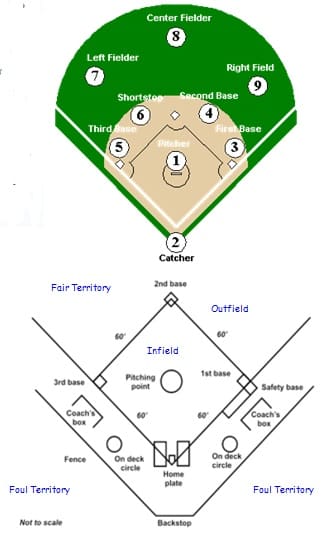Slo-pitch is a team sport in which a ball is thrown by a player called a pitcher and hit by an offensive player called a batter with a round, smooth stick called a bat (usually wooden or metal). Scoring is accomplished by the batter running and touching a series of three markers on the ground called bases, and then running past a final marker, called the commitment line.
The playing field is divided into fair territory and foul territory. Fair territory is further divided into the  infield, the outfield, and the territory beyond the outfield fence.
infield, the outfield, and the territory beyond the outfield fence.
The field is defined by two baselines or foul lines that meet at a right angle at home plate. Behind home plate is a backstop. Home plate is often a rectangular strike mat and is placed on one corner of a diamond with bases at each corner. The bases other than home plate are square, of canvas or a similar material. The bases are numbered counter clockwise as first base, second base, and third base. First base is a double base that has one side that is orange and one side that is white. Outside first base is foul territory. The infield consists of the inside of the diamond and the adjacent space in which the infielders normally play. The outfield is the remaining space between the baselines and between the outfield fence and the infield. The infield is usually “skinned” (dirt), while the outfield has grass in regulation competitions.
Near the centre of the diamond is the pitching plate.
The Play begins when the umpire says “Play Ball“.
Decisions about play are made by umpires
A regular slo pitch game consists of 7 innings – but this can be modified so that each player on a team takes a turn, or a fixed number of turns are taken, or the game is run until the class is over! In each inning of a regular game, each team bats until three batters have been put out. The teams take turns batting. Which team bats first is decided by a coin toss, or in our class by a RPS match. In the event of a tie, extra innings are usually played until the tie is broken. In all forms of slo pitch, the defensive team is the fielding team; the offensive team is at bat or batting and is trying to score runs.
The pitcher stands at the pitching plate and attempts to throw the ball past the batter to the catcher behind home plate. The throw, or pitch, must be made with an underhand motion: the ball must be released below the hip when the hand is no farther from the hip than the elbow. The pitcher tries to throw the ball so that it passes through the strike zone and lands on the strike mat. A pitch that passes through that zone and lands on the strike mat is a strike. A pitch that the batter swings at is also a strike, as is any hit ball that lands in foul territory (unless two strikes have already been called).
A pitch which is not a strike and which the batter does not swing at is a ball. The number of balls and strikes is called the count. The number of balls is always given first, as 2 and 1, 2 and 2, and so on. If the ball lands foul, it is a dead ball and no plays may be made until the pitcher receives the ball again, and the home plate umpire says, “Play ball.”
If four balls are called, then it is a walk. The batter gets to walk to first and if there is a runner on first the runner gets to advance to second.
Once the ball is hit into fair territory the runner must try to advance to first base or beyond. While running to first base, the batter is a batter-runner. When she safely reached first she becomes a base-runner or runner.
A batted ball hit high in the air is a fly ball. A fly ball hit upward at an angle greater than 45 degrees is a pop fly. A batted ball driven in the air through the infield at a height at which an infielder could play it if in the right position is a line drive. A batted ball which hits the ground within the diamond is a ground ball. If a batted ball hits a player or a base it is considered to have hit the ground.
The batter is out if: three strikes are called (a strikeout); a ball hit by the batter is caught before touching the ground (a flyout or pop fly); the batter is touched by the ball or by a glove holding the ball while the batter is away from a base (tagged); a fielder holding the ball touches a base which is the only base towards which the batter may run before the batter arrives there (a force out or force play); or in certain special circumstances.
If the player hits the ball and advances to a base without a fielding error or an out being recorded, then that is called a base hit. After hitting the ball, the batter may advance as many bases as possible. An advance to first base on the one hit is a single, to second base is a double, to third base is a triple, and to home plate is a home run. In Slo Pitch it is not permitted to steal bases.
